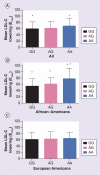Genetic variation in the UGT1A locus is associated with simvastatin efficacy in a clinical practice setting
- PMID: 25493567
- PMCID: PMC4292894
- DOI: 10.2217/pgs.14.128
Genetic variation in the UGT1A locus is associated with simvastatin efficacy in a clinical practice setting
Abstract
Aim: Simvastatin is a lactone prodrug that exists in equilibrium with its active hydroxyacid through a process mediated by UGT1A enzymes. The UGT1A locus has been associated with simvastatin response and disposition in humans. Therefore, we fine-mapped the UGT1A locus to identify genetic variations contributing to simvastatin disposition and response variability. Methods: Using de-identified electronic medical records linked to a DNA biobank, we extracted information about dose and low-density lipo-protein cholesterol (LDL-C) concentrations for patients who received more than two different doses of simvastatin. Pharmacodynamic measures of simvastatin potency and efficacy were calculated from dose-response curves (E0 = baseline LDL-C, ED50 = dose yielding 50% maximum response, and Emax = maximum decrease in LDL-C) in 1100 patients. We selected 153 polymorphisms in UGT1A1 and UGT1A3 for genotyping and conducted genotype-phenotype associations using a prespecified additive model. Results: Two variants in UGT1A1 (rs2003569 and rs12052787) were associated with Emax (p = 0.0059 and 0.031, respectively; for rs2003569 the mean Emax was 59.3 ± 23.0, 62.0 ± 22.4, and 69.7 ± 24.8 mg/dl, for patients with 0, 1 or 2 copies of the minor A allele, respectively). When stratified by race, the difference in response was greater in African-Americans than in European Americans. Rs2003569 was also negatively associated with total serum bilirubin levels (p = 7.85 × 10-5). Four rare SNPs were nominally associated with E0 and ED50. Conclusion: We identified a UGT1A1 promoter variant (rs2003569) associated with simvastatin efficacy. Original submitted 26 March 2014; Revision submitted 26 August 2014.
Keywords: LDL-cholesterol; UGT1A1; pharmacodynamics; pharmacokinetics; promoter variants; simvastatin.
Figures



Similar articles
-
Individualized Dose-Response to Statins Associated with Cardiovascular Disease Outcomes.JACC Adv. 2024 Apr;3(4):100894. doi: 10.1016/j.jacadv.2024.100894. Epub 2024 Mar 7. JACC Adv. 2024. PMID: 38737008 Free PMC article.
-
Characterization of statin dose response in electronic medical records.Clin Pharmacol Ther. 2014 Mar;95(3):331-8. doi: 10.1038/clpt.2013.202. Epub 2013 Oct 4. Clin Pharmacol Ther. 2014. PMID: 24096969 Free PMC article.
-
Effects of statin treatments and polymorphisms in UGT1A1 and SLCO1B1 on serum bilirubin levels in Chinese patients with hypercholesterolaemia.Atherosclerosis. 2012 Aug;223(2):427-32. doi: 10.1016/j.atherosclerosis.2012.06.002. Epub 2012 Jun 13. Atherosclerosis. 2012. PMID: 22749334
-
Comparison of low-density lipoprotein cholesterol reduction after switching patients on other statins to rosuvastatin or simvastatin in a real-world clinical practice setting.Am J Manag Care. 2007 Dec;13 Suppl 10:S270-5. Am J Manag Care. 2007. PMID: 18095777 Review.
-
Pharmacodynamics and pharmacokinetics of the HMG-CoA reductase inhibitors. Similarities and differences.Clin Pharmacokinet. 1997 May;32(5):403-25. doi: 10.2165/00003088-199732050-00005. Clin Pharmacokinet. 1997. PMID: 9160173 Review.
Cited by
-
Drug-drug-gene interactions as mediators of adverse drug reactions to diclofenac and statins: a case report and literature review.Arh Hig Rada Toksikol. 2021 Jun 28;72(3):114-128. doi: 10.2478/aiht-2021-72-3549. Arh Hig Rada Toksikol. 2021. PMID: 34187111 Free PMC article. Review.
-
Effects of Silymarin on the In Vivo Pharmacokinetics of Simvastatin and Its Active Metabolite in Rats.Molecules. 2019 Apr 28;24(9):1666. doi: 10.3390/molecules24091666. Molecules. 2019. PMID: 31035343 Free PMC article.
-
Impact of Vancomycin-Induced Changes in the Intestinal Microbiota on the Pharmacokinetics of Simvastatin.Clin Transl Sci. 2020 Jul;13(4):752-760. doi: 10.1111/cts.12761. Epub 2020 Mar 29. Clin Transl Sci. 2020. PMID: 32058642 Free PMC article. Clinical Trial.
-
Effects of Simvastatin on Pharmacokinetics and Anticoagulant Effects of Dabigatran in Healthy Subjects.Pharmaceuticals (Basel). 2023 Feb 27;16(3):364. doi: 10.3390/ph16030364. Pharmaceuticals (Basel). 2023. PMID: 36986464 Free PMC article.
References
-
- Evaluating statin drugs to treat high cholesterol and heart disease. www.consumerreports.org/health/resources/pdf/best-buy-drugs/StatinsUpdat....
-
- Prueksaritanont T, Subramanian R, Fang X, et al. Glucuronidation of statins in animals and humans: a novel mechanism of statin lactonization. Drug Metab. Dispos. 2002;30(5):505–512. [First study to show formation and quantification of acyl glucuronide conjugates of the hydroxy acid forms of simvastatin and two other statins in humans and animals.] - PubMed
-
- Mackenzie PI, Owens IS, Burchell B, et al. The UDP glycosyltransferase gene superfamily: recommended nomenclature update based on evolutionary divergence. Pharmacogenetics. 1997;7(4):255–269. - PubMed
-
- Owens IS, Ritter JK. Gene structure at the human UGT1 locus creates diversity in isozyme structure, substrate specificity, and regulation. Prog. Nucleic Acid Res. Mol. Biol. 1995;51:305–338. - PubMed
Grants and funding
LinkOut - more resources
Full Text Sources
Other Literature Sources
Molecular Biology Databases
